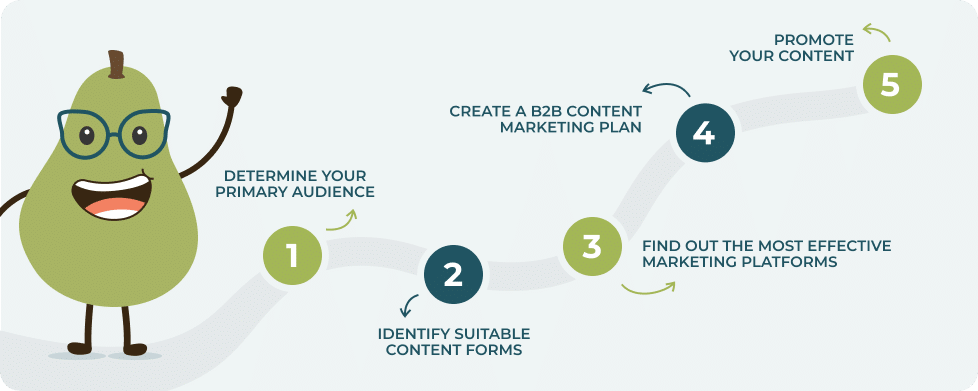Are your products and services essential to companies and organizations looking to improve operations, produce goods, and solve critical challenges? If yes, you need an excellent B2B content marketing strategy.
Taking a business-to-business (B2B) approach and positioning your content in places where key stakeholders will see it early and often is the goal. Fortunately, creating a B2B content marketing plan is something other than rocket science.
You just need to establish your strategy by our best practices, and then adjust your approach to best align your plan with the needs of your target audience. Ready to get started?
What is a B2B Content Marketing Strategy

A B2B Content Marketing Strategy is an approach businesses use to reach other companies by creating, publishing, and distributing valuable content.
This strategy, primarily aimed at attracting and engaging a business audience, is designed to build trust, nurture relationships, and generate leads. Content can take many forms, including blog articles, white papers, case studies, webinars, and social media posts.
Lastly, the goal is to provide helpful and relevant content that solves common business problems or addresses the target audience’s needs, thereby positioning the business as a trusted expert.
If you have a small business and are new to Digital Marketing, feel free to check out our Top Digital Marketing Ideas to Grow Your Business!
Differences between a B2B and a B2C strategy
Keep all these differences between B2C and B2B content marketing in mind as you create and follow your plan to get great results at every step.
The distinction between B2B (Business to Business) and B2C (Business to Consumer) content marketing, although becoming increasingly nuanced, still hinges on several critical differences:
- The decision-making process in B2B scenarios often involves multiple stakeholders, necessitating the need to communicate effectively with a broader group. Unlike B2C, where decisions often rest with the individual consumer, B2B marketing must navigate and engage with a collective approach to problem-solving.
- B2B transactions are typically driven by calculated decisions based on the perceived value of the solution. Businesses generally do not make impulsive purchases but scrutinize the potential outcomes thoroughly. Therefore, B2B content must have robust evidence of effectiveness, like statistics, factual data, and graphical representations.
- The tone of communication, or brand voice. While B2C marketing can afford to infuse personality and establish individual connections, B2B communication requires a more professional and formal style, mirroring a corporate meeting environment.
5 Steps to Create a B2B Content Marketing Strategy

Creating a B2B Content Marketing Strategy is a process where many variables must be identified, not only about your customers or objectives but also about your product or services. We have summarized this process in 5 main and easy-to-understand steps:
Determine Your Primary Audience
Determining your primary audience is crucial to convey your message or sell a product or service effectively. Start by analyzing your product or service to understand who it’s most applicable to.
So, you can start defining the features of your audience. Identify demographics such as age, gender, occupation, or location. Then, consider the psychographics like interests, attitudes, and behaviors.
You can’t leave competitors out. You can gain insights from customer reviews, social media interactions, and discussions in forums about similar businesses.
Identify Suitable Content Forms

Identifying the appropriate platform for publishing your content depends on various factors:
Audience. What is the platform your customers would use to find you? What channel do they use to communicate or buy your product or service? Is your content more visual or written?
Format. If it's visually strong, platforms like Instagram or Pinterest might be suitable; for text-heavy content, consider a blog or LinkedIn.
Goals. LinkedIn could be ideal if you want to build a professional network; if your goal is to engage a younger audience, platforms like TikTok or Snapchat might be more effective.
Many brands choose to publish on as many channels as possible in order not to discard getting customers and audiences from different media. This strategy can be costly in terms of resources, besides the fact that identifying the right channel could be enough.
Did you know that video is one of the best ways to reach your audience through social media? Be sure to check out our Video Marketing guide, with strategies, tips and examples!
Find out the Most Effective Marketing Platforms
To maintain constant engagement with your target audience, your content must continuously flow on the main B2B channels. Start developing e-books, case studies, white papers, and other content for your website. Set up private landing pages that allow you to deliver your most valuable content in exchange for your customers' contact information.
Use this contact information to send emails that direct your customers to webinars, podcasts, guest posts, and more. In addition, create email newsletters highlighting all the top solutions for each company on your list.
Also, publish long-form articles on LinkedIn to solidify your brand as a thought leader in the industry. Promote existing content on LinkedIn and other popular platforms, keeping your brand in stakeholders' minds as they make purchasing decisions.
Here, you should already start creating your B2B Content Marketing Strategy to move on to the planning phase.
Create a B2B Content Marketing Plan
The key to B2B content marketing lies in being consistent. So, to ensure you’re always writing, publishing, and promoting on schedule, create a B2B content marketing calendar. Organize a spreadsheet for each quarter and then start filling it out.
Divide the calendar into topics that are relevant to your business and your customers, and research the following about each topic:
- Main keyword and all the information needed to write about a complete topic correctly.
- Best distribution channel.
- Promotion plans (if applicable).
- Assigned writer and contributors.
- Deadline for publication. This is important, and only you can determine how often to publish so you can use your competitors as a guide or hire a professional who knows your audience.
- Also, include any links to images, videos, or podcasts you want to have on that page. The idea is to enhance your content with helpful external content.
If you have doubts about what to do at the beginning, don’t worry, we have made a whole post about the Digital Marketing Trends for this year.
Promote Your Content

Once you have defined what type of content you will create, for whom, where, and when you will publish it, you can start posting. Although you should choose a primary distribution channel, you can also promote your publications (from this main channel) on other platforms. Here are a few steps to consider:
- SEO (Search Engine Optimization): Ensure your content is SEO-optimized with relevant keywords, meta tags, and descriptions. This will increase its visibility on search engine results pages (SERPs), driving organic traffic to your content.
SEO can be quite a task, especially if you are just starting out. That’s why we’ve created a comprehensive guide about SEO basics. - Social Media: Use social media platforms like LinkedIn, Twitter, and Facebook to share your content. These platforms offer exceptional reach and engagement potential for B2B audiences.
- Email Marketing: Leverage your email list to disseminate your content directly to interested parties. Craft enticing subject lines and ensure your content provides value to encourage increased open rates and engagement.
- Content Syndication: Syndicate your content on popular platforms or industry-related sites to reach a broader audience
Remember, the key to effective B2B content promotion is delivering value. Know your audience, understand their pain points, and ensure your content addresses these while providing actionable insights.
Best Practices for a B2B Content Marketing Strategy
Before you publish your B2B Content Marketing Strategy, following certain best practices is essential.
- Ensure your content is tailored to your target audience; it should address their challenges and provide valuable solutions.
- Remain consistent with your brand voice and messaging. An unvarying tone of communication reinforces your brand identity
- Include a clear and compelling call-to-action (CTA) to guide your audience towards the desired action.
- Optimize your content for SEO; use relevant keywords, meta descriptions, and alt tags to improve visibility on search engines.
Remember, a well-planned and meticulously executed content marketing strategy can significantly enhance your B2B marketing outcomes.



